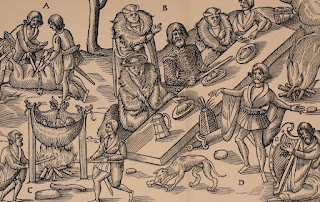 |
| Derricke's Image of Ireland, 1581 |
The "Mantle of Saint Brigid" at Bruges is the title of a paper published in the Journal of the Royal Society of Antiquaries of Ireland in 1936. The author, Major Henry Foster McClintock (1871-1959), had a particular interest in historical dress and published a book on the subject, Old Irish and Highland Dress, in 1943. He was born in Dublin the first child of the sailor and polar explorer Francis Leopold McClintock, who was instrumental in uncovering the fate of the lost Antarctic expedition led by Sir John Franklin. After a military career Henry McClintock returned to Ireland in 1928 and settled in Ardee, County Louth. In his paper on Saint Brigid's mantle, McClintock begins by pointing out that the name of this relic is somewhat misleading:
...the name of "Mantle" is really a misnomer; it is not a complete cape or garment of any sort but simply a rectangular piece of woollen cloth measuring about 21 by 25 inches, of a dark crimson colour, and covered all over on its face with tufts of curly wool resembling the fleece of a sheep.However, he goes on to explain that at one time this fleecy woollen cloth was enclosed in what sounds like a type of fabric reliquary in the form of a silk cape:
Until about 70 years ago it had the appearance of a cape, or shoulder-cloak, of yellow silk interwoven with gold thread and decorated with gold lace...But in 1866, when it was examined ..the cape was found to be merely a decorative covering which appeared from the nature of its materials to have been made in about the year 1400. The original relic was discovered inside, and was found to consist of a piece of shaggy cloth, with some sort of lining of blue and green linen which showed signs of wear. It was at this time that the silk covering was removed and the relic enclosed in the glazed wooden case in which it is now kept...The cloth was next examined in 1935 by a staff member of the Department of Textiles of the Royal Museum, Brussels, and McClintock provided a translation of the report. This is how the relic was described on that occasion:
In its present condition the fragment of St Brigid's cloak consists of a rectangular bit of stuff measuring 0.545m. wide and 0.64m. long (about 21 by 25 inches), kept in a modern triptych-shaped reliquary. It consists of a deep violet woollen fabric, to which a light lining of red silk taffeta was added - by oversewing it to the edges - after its official recognition in 1866. This woollen fabric is characterised by a thick curly fleece which entirely covers its outer surface, giving it the effect of astrakhan fur. The reverse side is perfectly smooth, and thus it is easy to follow the interlacements of the threads of the warp and weft which is of the simplest form, being that used in making linen...We must add to this that the fabric underwent some alterations in 1866; darning in several damaged places and putting back strands which had become detached.
McClintock, H. F. (1936). The “Mantle of St. Brigid” at Bruges. The Journal of the Royal Society of Antiquaries of Ireland, 6 (1), 32–40. http://www.jstor.org/stable/25513808
McClintock saw this type of cloth as typical of the 'Shag-rug Mantles' worn in sixteenth century Ireland and mentioned by various English Tudor commentators. Some illustrations of these cloaks also survive including that from Derricke's Image of Ireland (1581) which I have reproduced above. It shows an Irish Chief with his wife and retinue at dinner. McClintock explains that "The Chief's wife is wearing a mantle with a shaggy exterior, while the two Friars appear to have similar mantles with the shaggy sides worn inwards." He admits that he cannot prove such mantles were made in the time of Saint Brigid but feels that it is reasonable to suggest that the weaving of such garments had a long history in Ireland and were part of a wider European tradition going back to the Bronze Age. He adds that a chemical analysis of a bit of the wool showed that the main dye used was iron oxide. The Belgian textile expert also informed McClintock that "she saw no signs of the green and blue lining said to have been attached to the piece of shaggy woollen cloth when the relic was examined and re-arranged in 1866."
In 1951 Major McClintock published a second article on The Mantle of Saint Brigid in the and in the next post we will examine the fascinating provenance of the relic and trace its journey from Ireland to Belgium.
Content Copyright © Trias Thaumaturga 2012-2022. All rights reserved.

No comments:
Post a Comment